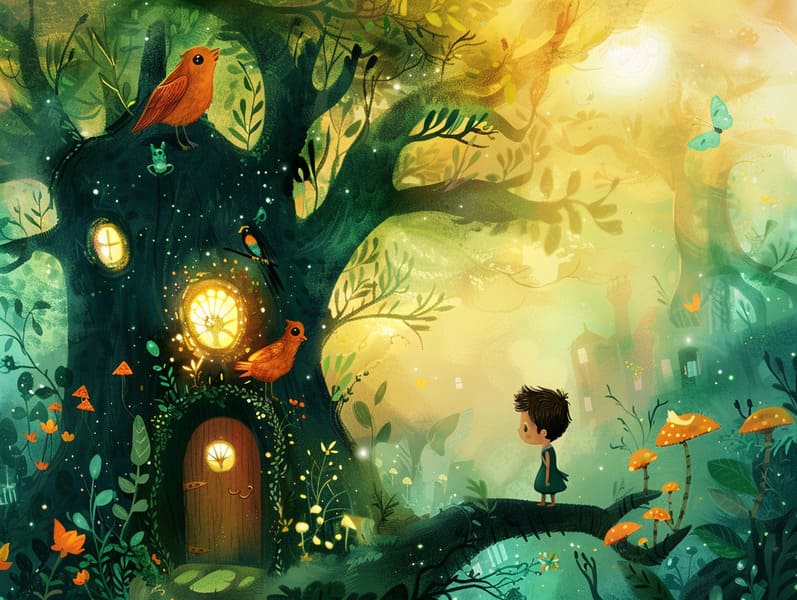The Birth of Fairy Tales for Kids with Its Consistent Captivation.
The Birth of Fairy Tales for Kids with Its Consistent Captivation.
Blog Article

Historical fairy tales have legendary status. These narratives have been whispered from one generation to the next far before they were ever inscribed. They originated from a variety of cultures, including African traditions. They were initially narrated among grown-ups, often carrying themes and messages aligned with the societal norms and beliefs of the time.
The famous Grimm duo, the two Grimm brothers, were among the first to compile and release many of these beloved tales. Their volume, "Grimm's Fairy Tales," included stories like "The Story of Cinderella," "The Story of Hansel and Gretel," and "Schneewittchen," which have since become mainstays in the world of famous fairy tales. Similarly, Hans Christian Andersen's fanciful stories, such as "The Mermaid," and "The Duckling that Could," have won hearts worldwide, guaranteeing their place in the pantheon of treasured fairy tales.
Despite their historical roots, traditional fairy tales remain as important as ever, especially as children's bedtime stories. These magical stories are now available in multiple formats, including artistically illustrated books, fantastical animations, and digital storybooks.
Their enduring popularity can be credited to several captivating elements:
Ethical Lessons: Traditional fairy tales often share important moral lessons. Tales like "The Tale of the Boy Who Cried Wolf" teach the significance of truthfulness, while "The Story of the Tortoise and the Hare" show the qualities of tenacity and modesty. These tales offer young readers clear distinctions between virtue and vice, building their moral compass in a mild yet deep way.
Sympathy and Perception: Ancient fairy tales frequently involve protagonists facing tests and troubles, fostering kids to empathize with their struggles and support their triumphs. For instance, "The Tale of Beauty and the Beast" highlights the importance of seeing inner beauty to appreciate the inner core of a character, promoting understanding and discernment.
Cultural Perception: Many timeless fairy tales are deeply ingrained in the cultural contexts from which they originated. Immersing in these narratives can provide enlightening views into different traditions, nurturing a sense of world appreciation and understanding.
Creativity and Imagination: The enchanted elements in fairy tales—talking animals—revitalize children’s fantastical thinking. These stories move readers to fantastical realms, enhancing fantasy dreams and a sense of fascination that stays a lifetime.
Old fairy tales are not only delightful but also instructive. They act as fascinating tools in enhancing various mental and emotional abilities in young readers. When classic fairy tales are voiced, they foster speech development by introducing new vocabulary and complex sentence structures. This practice also promotes hearing perception and attentiveness, as children pay close attention, prepared to see what happens next.
Furthermore, discussing the themes and characters of ancient fairy tales can strengthen cognitive skills and problem-solving abilities. Young ones are guided to see patterns, forecast, and figure out cause and effect. These deliberations also aid kids convey their thoughts and feelings, fostering their emotional intelligence.
In today’s modern era, the availability of digital fairy tales has made these tales more within reach than ever. Internet resources and digital apps offer vast collections of traditional fairy tales that can be seen or listened through anytime, anywhere. Fairy tales recited are particularly common, making available an interactive way for kids to delight in these whimsical stories. Voice books and read-out-loud videos bring characters and settings to life, often complemented by whimsical music and musical scores that enrich the narrative journey.
The lasting appeal of classic fairy tales lies in their ability to alter to present days while staying true to their core messages. Contemporary takes of these tales often integrate more varied characters and modern settings, making them relatable to today’s audience. However, the underlying themes of fearlessness, warmth, and truth remain unchanged, continuing find it here to appeal to readers of all ages.
Fairy tales also offer a sense of contentment and knownness. They deliver up a systematic narrative with a evident beginning, middle, and end, often drawing to a close with the solving of conflicts and the triumph of virtue over vice. This assuredness can be calming for little ones, distributing a sense of unchangeability in an unpredictable world.
Traditional fairy tales continue to enchant and inform new generations, maintaining their beauty and value in modern society. As bedtime stories for kids, they allow a perfect blend of fantasy and learning, sustaining moral values, empathy, and creativity. The accessibility of online fairy tales and the favor of fairy tales voiced assure that these old stories remain reachable to new generations.
By perpetuating and divulging these narratives, we continue to extol the rich tapestry of creativity and cultural heritage. Whether you are delving into a richly illustrated book, experiencing a digital collection, or listening via an audio story, the appeal of bedtime fairy tales is always within reach. These stories illustrate of the continued magic of fairy tales and its ability to bind us across epochs and places.
Even if you are enjoying a colorful picture book, enjoying a online collection, or listening through an read-aloud book, the loveliness of classic fairy tales is always within reach.
These stories teach us of the enduring influence of narratives and its ability to gather us across centuries and lands, forging a link that fascinates and enlightens alike.